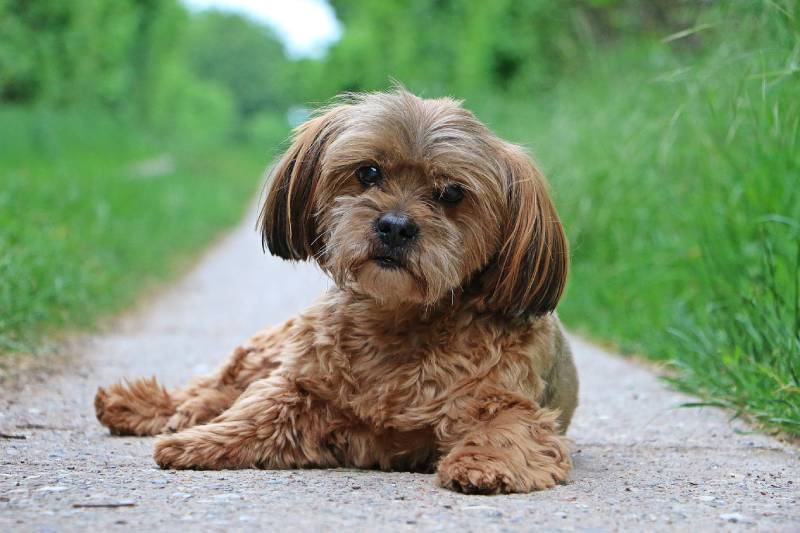Click Below to Skip Ahead
You’ve probably seen a Lhasa Apso (even if you didn’t know the name of the breed). These absolutely lovely canines are an older dog breed, as they have been around for at least a thousand years. Back then, these pups worked as guard dogs for Buddhist monks, but these days, the Lhasa Apso is more inclined to be a family pet (although they still make excellent watchdogs!).
If you want to add a dog to your home, you may find that the confident, stubborn, and loyal Lhasa Apso is just the right dog for you. Want to learn more about the breed so you can decide whether adopting one is the best decision for you? We’ve gathered all you need to know below!
Breed Overview
Height:
9 – 11 inches
Weight:
12 – 18 pounds
Lifespan:
12 – 15 years
Colors:
Silver, liver, black, tan & black, gray, charcoal, cream, golden, white, blue, grizzle, red gold, red
Suitable for:
Families, those living in smaller spaces, singles
Temperament:
Confident, alert, affectionate, intelligent
The Lhasa Apso is a breed that has been around for quite a while (and is one of the parent breeds of the Shih Tzu!). With their long coats, these dogs are a sight to behold. Though they can be cranky and stubborn at times, these canines offer their human families a fierce devotion that can’t be matched.
Lhasa Apso Characteristics
Lhasa Apso Puppies

The Lhasa Apso is a popular breed, so you may want to check your local shelter or a rescue organization before heading to a breeder. If you do go the breeder route, make sure you’re using a reputable one. Lhasa Apsos are on the pricier side, so if a breeder is trying to sell you one for cheap, it’s probably either not purebred or comes from a puppy mill. Not going with a reputable breeder also means the puppy may not be as healthy as one that would come from a reputable breeder.
These dogs will be super affectionate right off the bat, as well as playful. One important thing to know before bringing a Lhasa Apso home, though, is that this breed is quite vocal, so expect plenty of barking. If you want your pup to bark less, you’ll need to begin training them right away!
Lhasa Apso Origin & History
The Lhasa Apso has been around for at least a thousand years. This breed comes to us by way of Tibet, where these dogs used to be sentinels at Buddhist monasteries and palaces. In Tibet, this breed is believed to be an earthly representative of the Snow Lion (a mythical creature known in folklore to be the protector of Tibet). Long associated with the Dalai Lama, the Lhasa Apso came to the U.S. at the tail end of the 1940s when the 14th Dalai Lama gave them as gifts.

Temperament & Intelligence of the Lhasa Apso 🧠
The Lhasa Apso has confidence to spare. This small breed believes they are much larger and tougher than they actually are; in fact, in Tibet, they are also called “abso seng kye” (or “bark lion sentinel dog”). That confidence is great, but it also means that these dogs are independent and tend to go their own way at times. Add that independence to their high intelligence, and you have one excellent dog (although they can sometimes be a challenge to train!).
This breed is more than their confidence and intelligence, though. These pups are the family comedians, up for affection and playtime often (but on their own terms). You’ll also find they are intensely devoted and loyal to their people. This loyalty and devotion can translate into them being rather stand-offish with strangers, though. But it also means they’ve always got your back!
Are These Dogs Good for Families? 🏡
This breed can make a fantastic pet for families, but it requires a bit of work if you have kids in the home. Because of their “large and in charge” attitude, a Lhasa Apso playing with children can take on a dominant role, leading to issues. But by starting socialization with your pup as soon as you bring them home, you help negate their need to be in charge, so they get along better with children. You’ll also want to be sure that you train your dog not to nip or growl at kids who are on the rowdy side and ensure children understand how to respect the dog’s boundaries.
Once your pup is properly trained, though, you can expect to have a fun-loving and adventurous dog who gets along with all!
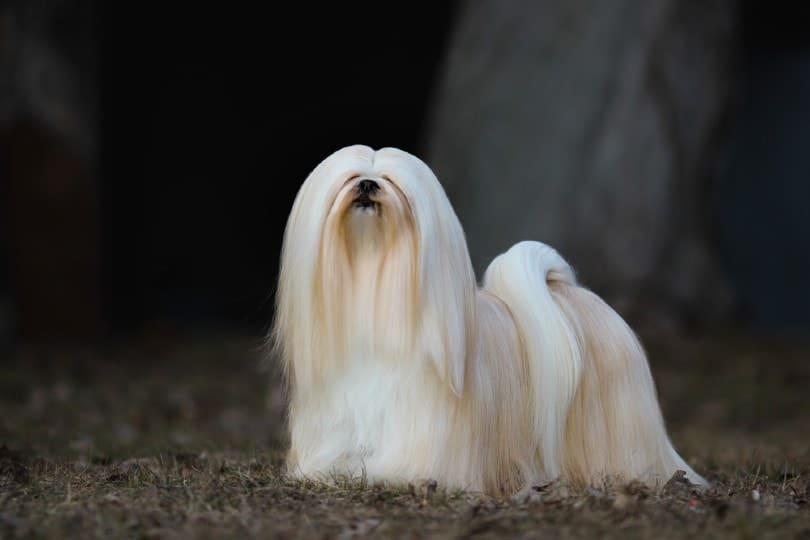
Does This Breed Get Along With Other Pets? 🐶 😽
Like with children, the Lhasa Apso can get along with other pets in the home, but it depends greatly on how well they are socialized at a young age. A puppy who has been socialized and trained can befriend other dogs and sometimes even cats. Even if they’re on friendly terms with others, though, this canine will still want to be in charge, so keep an eye on things to ensure no issues arise.
Things to Know When Owning a Lhasa Apso
You’ll have to know much more than the Lhasa Apso’s temperament to care for one properly, though. Here, you’ll find everything you should know, including the breed’s grooming needs and potential health concerns.
Food & Diet Requirements 🦴
Like all dogs, the Lhasa Apso requires a diet of high-quality dog food. But since they tend to have thicker skin (needed to support those beautiful, heavy coats of theirs), whatever dog food you feed them should include plenty of protein and fats. While the source of the protein (chicken, turkey, etc.) will depend on what your pup prefers, it’s advised that the fat content of the food be 14% or higher.
Be careful with how much you feed your pup, though, as even overeating a little can cause these dogs to experience unpleasant digestive issues. Speak with your vet if you aren’t sure how much food a day will work for your pet.
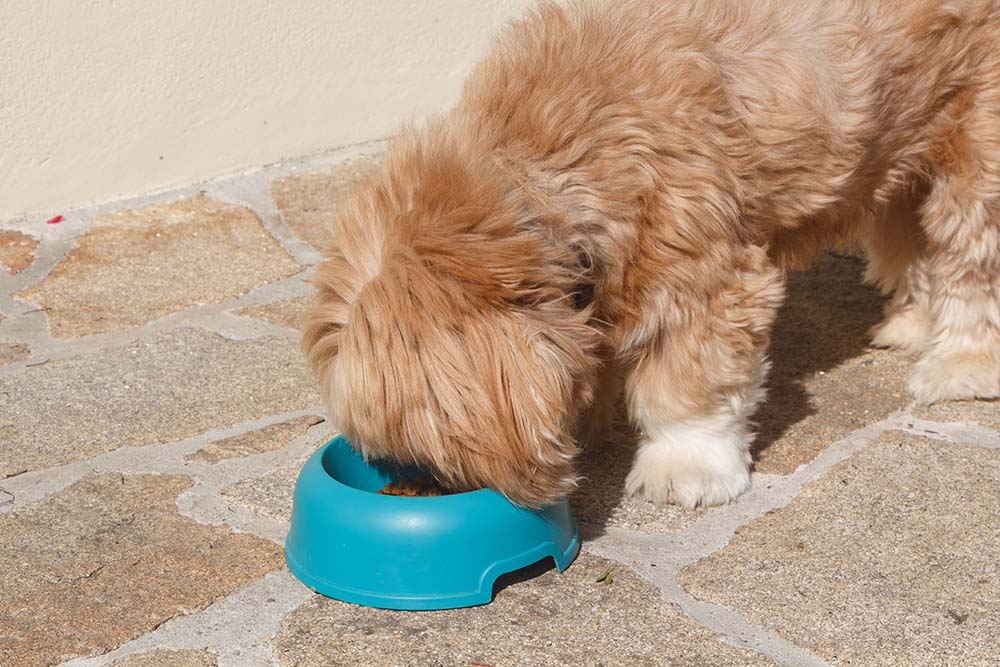
Exercise 🐕
The Lhasa Apso may believe it’s a big dog capable of incredible feats, but that isn’t often the case. When it comes to exercise, these dogs will be raring to go, but they’ll typically be tuckered out after about 20 minutes of walking, running, or playing. One great thing about these pups is that they’re wonderful at exercising themselves. If they need to burn off some energy, they’ll run around the backyard or apartment until tired.
That doesn’t mean you don’t need to exercise your dog yourself, though. A daily walk, playing fetch in the backyard, or setting up an agility course for your dog are all excellent ways to ensure they get the exercise they need. Also, make sure to have plenty of toys on hand for your Lhasa Apso so they have mental as well as physical stimulation.
Training 🦮
Training a Lhasa Apso is where you may run into a smidge of trouble. These pups are more than eager to please—as long as it also pleases them. This breed is intelligent, but they have that independent streak that can sometimes make them somewhat willful. The trick is to make training interesting. Avoid repetitive training sessions; instead, mix things up.
Also, only use positive reinforcement with these canines. If they decide they feel badgered by you, they can become particularly stubborn and refuse to participate. Another tip is to keep things consistent. If training is inconsistent, the Lhasa Apso will notice that you aren’t taking it seriously, so they won’t either.
If you run into too much trouble, consider getting a professional trainer for them. Training and socialization aren’t things you can skip out on with these pups, so get some help if you need it!
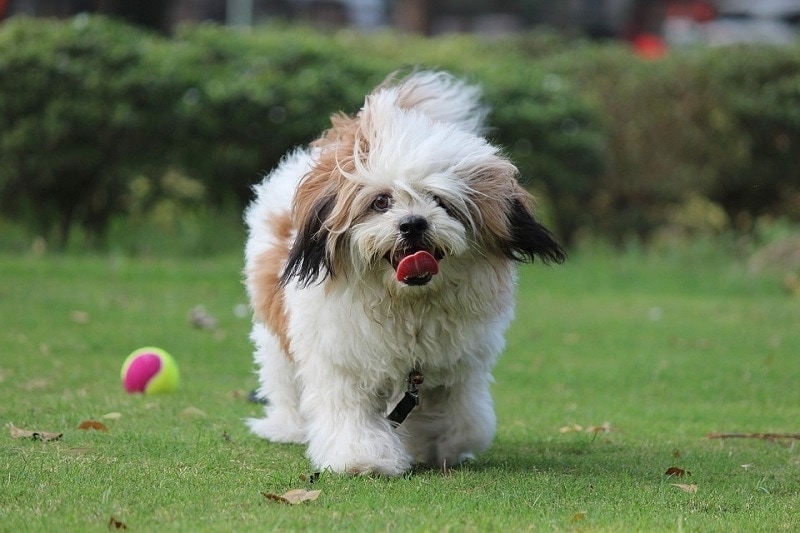
Grooming ✂️
The amount of grooming you need to do for a Lhasa Apso somewhat depends on whether you keep their coat long or cut it short. You can have a groomer cut your pup’s coat every couple of weeks to keep it on the shorter side, which means you only need to brush it out a few times a week. If your dog has a long coat, though, daily brushing is required to prevent tangles and mats from forming. For this, you can use both a comb and a stiff brush.
Your pup will require bathing every two to four weeks (two weeks for longer hair). You can do this at home or have a groomer do it. You’ll want to brush your pet before bathing them to ensure no tangles or mats are in their hair, then brush them again afterward.
For non-coat-related grooming, you’ll want to keep your pup’s nails trimmed and brush their teeth on a regular basis. Also, look at your dog’s ears, paws, eyes, and nose each week to ensure there are no signs of irritation. If you find signs of irritation, you may need to visit your vet.
Health and Conditions ❤️
This is one canine breed that is incredibly healthy! The Lhasa Apso is known for its long lifespan and good health. That doesn’t mean there aren’t any health conditions they are prone to, though. Here are a few things your pup might develop.
- Dry eye
- Cherry eye
- Progressive retinal atrophy
- Hereditary kidney dysfunction
- Hip dysplasia
Male vs Female
The major difference between the males and females of this breed will be in size, as males are slightly larger and heavier than females. When it comes to personality, males and females will be mostly the same, though males might be a bit more independent, while females may be a little shyer. The other thing to consider when deciding between a male and female dog is the cost of having them fixed; spaying is more expensive than neutering.
3 Little-Known Facts About the Lhasa Apso
There’s more to know about the Lhasa Apso, but we’ll leave you with these three final facts you might not have known.
1. Lhasa Apsos are thought to be the earthly representatives of the Snow Lion.
In Tibetan folklore, the Snow Lion is thought to be the protector of the country, while the Lhasa Apso is believed to be an earthly representative of said Snow Lion.
2. The name of this dog comes from a city.
At least, the “Lhasa” part does. Lhasa is the most sacred city in Tibet; Apso simply means “long-haired dog.”
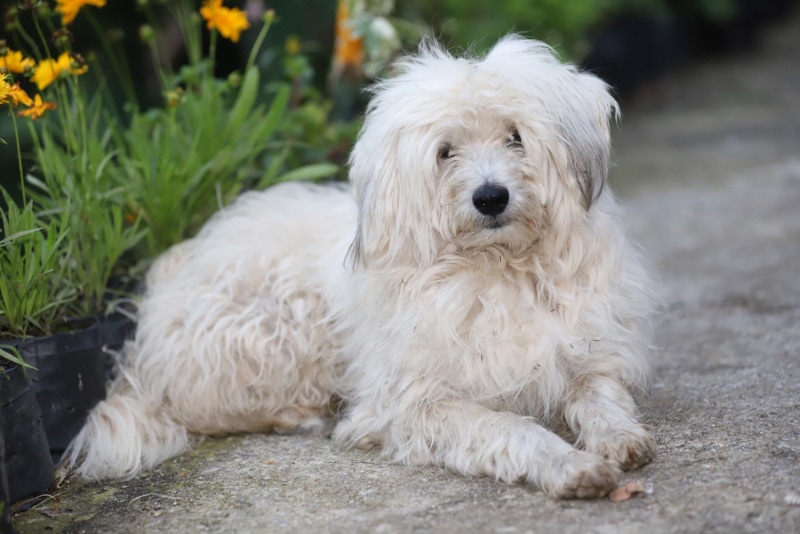
3. The Lhasa Apso came to the U.S. by way of the Dalai Lama.
The 14th Dalai Lama bred these dogs in the 1940s and gave them as gifts, which is how the breed became established in the United States.

Final Thoughts
The Lhasa Apso can make a fantastic pet for the right person! These beautiful small dogs have big personalities that make them confident comedians. Watch out for that confidence, though, because it can also cause these pups to have a wide independent streak that can be challenging. These canines can do well in homes with backyards or smaller spaces, like apartments, so they should be fine wherever you live.
If you add one of these pups to your home, you’re in for a lot of fun and a bit of difficulty; it will be well worth it, though!
Featured Image Credit: Bianca Grueneberg, Shutterstock

